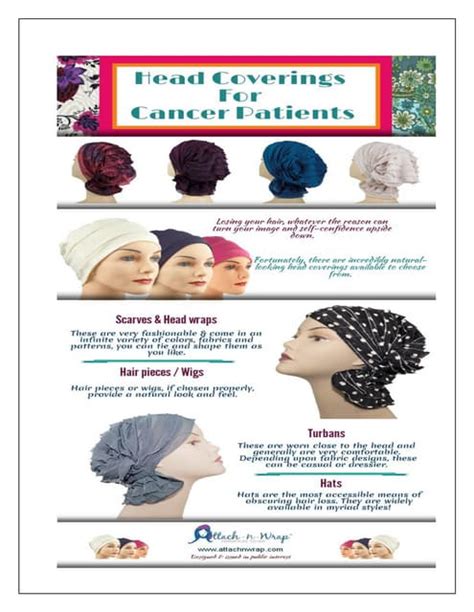Cancer patients face numerous challenges during treatment, including hair loss. Head coverings can provide comfort, warmth, and a sense of self-confidence during this difficult time.

Types of Head Coverings
- Wigs: Synthetic or human hair wigs offer a realistic look and can be styled to match natural hair.
- Hats: Beanies, scarves, and other hats are comfortable and practical options that can also make a fashion statement.
- Headwraps: Made from various fabrics, headwraps are versatile and can be worn in different styles.
- Turbans: Silky or cotton turbans provide a turban-like look and can be dressed up or down.
- Bandanas: Lightweight and easy to wear, bandanas can be folded or tied in different ways.
Benefits of Head Coverings
- Comfort: Head coverings protect the scalp from irritation and reduce sensitivity to cold.
- Warmth: They help regulate body temperature and prevent heat loss.
- Privacy: They can conceal hair loss, providing privacy and reducing anxiety.
- Protection: Head coverings shield the scalp from UV rays and dust.
- Confidence: They can help patients feel better about their appearance and boost their self-esteem.
Choosing the Right Head Covering
Consider the following factors when choosing a head covering:
- Treatment type: Different treatments cause varying degrees of hair loss, influencing the coverage needed.
- Scalp sensitivity: Choose soft, natural fibers that won’t irritate the scalp.
- Personal style: Head coverings come in a wide range of colors, patterns, and designs to match personal preferences.
- Activity level: For active individuals, breathable and moisture-wicking materials are crucial.
Psychosocial Impact of Head Coverings
Head coverings play a significant role in the psychosocial well-being of cancer patients. According to the National Cancer Institute, “Head coverings can make patients feel more confident, less self-conscious, and more in control of their appearance.”
Hair Loss and Emotional Distress
Hair loss is a common side effect of cancer treatment that can cause emotional distress. A study published in the Journal of the American Academy of Dermatology found that “hair loss can lead to feelings of sadness, anxiety, depression, and decreased self-esteem.” Head coverings can help mitigate these emotions by providing a sense of coverage and normalcy.
Head Coverings and Spirituality
For some patients, head coverings hold spiritual or religious significance. In many cultures, covering the head is a sign of respect or humility. Head coverings can provide a connection to faith and a sense of peace during treatment.
Resources for Cancer Patients
Numerous organizations provide support to cancer patients, including information on head coverings.
- American Cancer Society
- Head Covering Foundation
- CancerCare
FAQs
1. What is the best material for a head covering?
Natural fibers like cotton, bamboo, and silk are soft and breathable.
2. How often should I wash my head covering?
Wash as needed, depending on the frequency of use and the type of material.
3. Can I wear a wig if I have sensitive scalp?
Some wigs have adjustable caps and are made of hypoallergenic materials.
4. How do I choose the right color and style of head covering?
Consider your natural hair color, skin tone, and personal preferences.
5. Are there head coverings specifically designed for men?
Yes, there are head coverings in various styles and colors designed for men.
6. Can I wear a head covering after cancer treatment?
Yes, head coverings can still provide comfort and support after treatment is complete.
